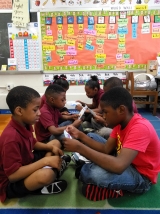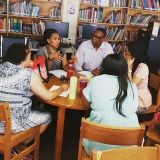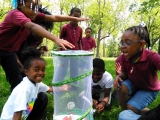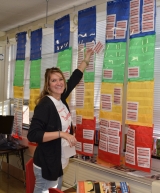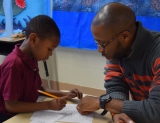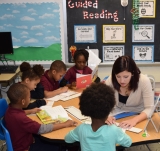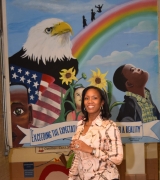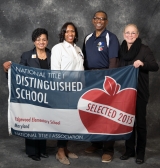-
Category 1
Selected in 2015
-
Grades: pre k - 5
School Setting: urban
Town Population: 622,793
Student Enrollment: 313
Student Demographics:
Black/African American: 97%
Teacher/Student Ratio: 1:18
White/Caucasian: 1%
Hispanic: 2%
Hawaiian/Pacific Islander: 0%
Asian: 0%
Native American: 0%
Other: 0%
% Reduced Lunch: 96.3%
% ELL Learners: 1.3%
Founded: 1957 -
PRINCIPAL:
Kimberly N. Sollers -
CONTACT:
1900 Edgewood Street
Baltimore, MD 21216
410-396-0531
ksollers@bcps.k12.md.us
Edgewood Elementary School
Baltimore, MD
There are many things that catalyze change in an educational environment. Edgewood believes that mission alignment is a critical component. Every program and initiative aligns to the goal of Edgewood. The school’s performance plan, teachers’ student learning objectives, and professional learning shape daily practices within the school.
- Describe specific programs in place to ensure that families are involved in the success of your school and students.
- It is imperative that families are involved in our students' academic careers. In order for students to be successful, we have implemented several programs that increase family involvement. Edgewood Elementary offers Homework Night, a program that allows parents to ask questions, solve problems, and understand the curriculum. Each classroom has also adopted Class Dojo, a behavior system that allows direct, real time communication with parents and family members. Edgewood also enforces PBIS, a behavior management system built on positive actions and student growth. Students are recognized for their hard work daily. Edgewood Elementary also celebrates student achievement through the PBIS pep rally, where community and families are also invited to acknowledge student success. Last, Edgewood has an outstanding Parent Teacher Organization, which provides students with opportunities when they have met their goals. The PTO also serves as a communication line between teachers and our community. The programs implemented at Edgewood have aided in student success and growth.
- Describe the most successful activity your school has initiated to strengthen ties to your community.
- Edgewood Elementary hosts an annual Spring Fling that connects the school and its families to its surrounding community. Edgewood partners with local businesses and political figures including City councilmen, health and mental agencies, the local library, and local artists. These members of the community are invited to connect with the families of Edgewood in order to create a strong community partnership. The Spring Fling is intended to provide an opportunity to learn about the services that are provided in the neighborhood while being updated about the current events of the school.
- Describe your philosophy of school change or improvement.
- There are many things that catalyze change in an educational environment. Edgewood believes that mission alignment is a critical component. Every program and initiative aligns to the goal of Edgewood. The school’s performance plan, teachers’ student learning objectives, and professional learning shape daily practices within the school. Administrators conduct regular classroom observations and provide teachers with actionable feedback to improve their practice. These practices, plans and programs implemented in the school propel each other to reach the educational goal. All are aligned to the mission of the school.
- What are your school’s top two goals for the next year?
- Edgewood continues to make student attendance a top priority for each academic school year. Teachers and administration strive to decrease chronic absenteeism by motivating students and parents to come to school on a consistent basis. The development of the staff’s ability to intellectually engage all students in the work is the second goal. These goals will require us to continue to place the students first and as the basis of our work. Our continued commitment to multi-level data analysis, willingness to take chances and resolve problems ensure we are ready to take on challenges in a collaborative and collective way.
- Describe the program or initiative that has had the greatest positive effect on student achievement, including closing achievement or opportunity gaps, if applicable.
- Through the use of our data analysis, the ILT formed and implemented a school wide intervention block. Members took a deep dive into each student’s individual assessment data to determine foundational skills that were preventing them from progressing toward academic goals. Students were grouped based on these foundational needs as opposed to traditional grade- level groupings. Within this intervention model, teachers were strategically paired with students groups based on their instructional strengths. Each teacher used diagnostic results to create a group learning plan that would directly address student needs. This program helped students make significant gains in their reading deficiency.
- Identify the critical professional development activities you use to improve teaching and student learning.
- The ILT provides a wide variety of professional development opportunities for Edgewood staff. Professional development sessions are focused around specific instructional practices that are encouraged by the school district, such as explicit instruction, routine writing, arts integration, and data analysis. During these opportunities, staff members are able to participate in hands-on activities that enhance and extend their learning, with time to discuss and ask questions pertaining to the topic. ILT members follow up with staff members to make sure the content has been presented clearly and teachers are able to apply the strategies and practices in their own instruction. Regular informal observations are conducted by the administrators from which teachers receive actionable feedback and support.
- Describe how data is used to improve student achievement and inform decision making.
- Edgewood has placed emphasis on the use of technology in order to improve student achievement and inform decision making. Teachers work collaboratively with grade level teammates to analyze student data in order to differentiate instruction and meet all students’ needs. Teachers look at the trends of the data in order to determine how to meet the different needs of each learner. In addition teachers and administrators engage in cycles of professional development to learn new instructional strategies. Teachers collect data by monitoring current teaching practices followed by adjusting practices according to the impact of the practices on student achievement.
- Describe your school culture and explain changes you’ve taken to improve it.
- Here at Edgewood we consistently revisit our school climate and culture. The culture of the school had once been academic excellence through teacher independence. Each teacher was dedicated to student improvement but accomplished this in isolation. Over time the Instructional Leadership Team has worked to increase the collaborative culture to where academic success is now achieved by working together. Resources have been aligned so that collaboration time among grade level teachers and administration are kept sacred. Parents and teachers collaborate through the increased use of technology. Teachers and students collaborate through conferences and interactive data walls.
Stats
-
Category 1
Selected in 2015
-
Grades: pre k - 5
School Setting: urban
Town Population: 622,793
Student Enrollment: 313
Student Demographics:
Black/African American: 97%
Teacher/Student Ratio: 1:18
White/Caucasian: 1%
Hispanic: 2%
Hawaiian/Pacific Islander: 0%
Asian: 0%
Native American: 0%
Other: 0%
% Reduced Lunch: 96.3%
% ELL Learners: 1.3%
Founded: 1957 -
PRINCIPAL:
Kimberly N. Sollers -
CONTACT:
1900 Edgewood Street
Baltimore, MD 21216
410-396-0531
ksollers@bcps.k12.md.us


